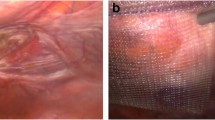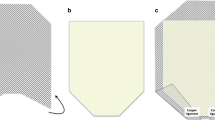Abstract
The use of prosthetic mesh has become the standard of care in the management of hernias because of its association with a low rate of recurrence. However, despite its use, recurrence rates of 1% have been reported in primary inguinal repair and rates as high as 15% with ventral hernia repair. When dealing with difficult recurrent hernias, the two-layer prosthetic repair technique is a good option. In the event of incarcerated or strangulated hernias, however; placement of prosthetic material is controversial due to the increased risk of infection. The same is true when hernia repairs are performed concurrently with potentially contaminated procedures such as cholecystectomy, appendectomy, or colectomy. The purpose of this study is to report our preliminary results on the treatment of recurrent hernias by combining laparoscopic and open techniques to construct a two-layered prosthetic repair using a four ply mesh of porcine small intestine submucosa (Surgisis®, Cook Surgical, Bloomington, IN, USA) in a potentially infected field and a combination of polypropylene and ePTFE (Gore-Tex®, W.L. Gore and Associates, Flagstaff, AZ, USA) in a clean field. From September 2002 to January 2004, nine patients (three males and six females) underwent laparoscopic and open placement of surgisis mesh in a two layered fashion for either recurrent incisional or inguinal hernias in a contaminated field. A total of eight recurrent hernia repairs were performed (five incisional, three inguinal) and one abdominal wall repair after resection of a metastatic tumor following open colectomy for colon carcinoma. Six procedures were performed in a potentially contaminated field (incarcerated or strangulated bowel within the hernia), two procedures were performed in a contaminated field because of infected polypropylene mesh, and one was in a clean field. Mean patient age was 56.4 years. The average operating time was 156.8 min. Operative findings included seven incarcerated hernias (four incisional and three inguinal), one strangulated inguinal hernia, and one ventral defect after resection of an abdominal wall metastasis for a previous colon cancer resection. In two of the cases, there was an abscess of a previously placed polypropylene mesh. All procedures were completed with two layers of mesh (eight cases with surgisis and one with combination of polypropylene/ePTFE). Median follow up was 10 months. Complications included two seromas, one urinary tract infection, two cases of atelectasis and one prolonged ileus. There were no wound infections. The average postoperative length of stay was 7.8 days. There have been no mesh-related complications or recurrent hernias in our early postoperative follow-up period. The use of a new prosthetic device in infected or potentially infected fields, and the two-layered approach shows promising results. This is encouraging and provides an alternative approach for the management of difficult, recurrent hernias.






Similar content being viewed by others
References
Read R (1989) Preperitoneal herniorraphy: a historical review. World J Surg 13:532–540
Mac Lean (1995) The repair of inguinal hernias. Ann Surg 231:1–2
Nyhus LM, Condon RE (1989) Hernia, 3rd edn. JB Lippincot Co, Philadelphia
Barber J, Carretier M, Richer JP (1989) Cooper ligament repair-an update. World J Surg 13:499–505
Heniford BT, Park A, Ramshaw B, Voeller G (2003) Laparoscopic repair of ventral hernias: 9 years experience with 850 consecutive hernias. Ann Surg 238:391–400
Ramshaw B, Shuler F, Jones HB, Duncan TD, White J, Wilson R, Lucas GW, Mason EM (2001) Laparoscopic inguinal hernia repair: lessons learned after 1224 consecutive cases. Surg Endosc 15:50–54
Franklin ME, Gonzalez JJ, Glass JL, Manjarrez A. (2004) Laparoscopic ventral and incisional hernia repair: an 11-year experience. Hernia 8:23–27
Condon RE (2001) Two-layer prosthetic tissue replacement repair. In: Nyhus “Mastery of Surgery”, 4th edn. Lippincott Williams & Wilkins, pp 1983–1990
Franklin ME, Gonzalez JJ, Michaelson RP, Glass JL, Chock DA (2002) Preliminary experience with new bioactive prosthetic material for repair of hernias in infected fields. Hernia 6:171–174
Langer S, Christiansen J (1985) Long-term results after incisional hernia repair. Acta Chir Scand 151:217–19
van der Linden FT, Vroonhoven TJ (1988) Long term results after correction of incisional hernia. Neth J Surg 40:127–129
Hesselink VJ, Luijendik RW, de Witt JH, Heide E, Jeekel J (1993) An evaluation of risk factors in incisional hernia recurrence. Surg Gynecol Obstet 176:228–234
Luijendijk RW, Hop WC, van den Tol MP, de Lange DC, Braaksma MM, IJzermans JN, Boelhouwer RU, de Vries BC, Salu MK, Wereldsma JC, Bruijninckx CM, Jeekel J (2000) A comparison of suture repair with mesh repair for incisional hernia. NEJM 343:392–398
Kugel RD (1999) Minimally invasive, non laparoscopic, preperitoenal, and suture less, inguinal herniorrhaphy. Am J Surg 178:298–302
White TJ, Santos MC, Thompson JS (1998) Factors affecting wound complications in repair ventral hernias. Am Surg 64:276–280
Leber GE, Garb JL, Alexander AI, Reed WP (1998) Long-term complications associated with prosthetic repair of incisional hernias. Arch Surg 133:378–382
Houck JP, Rypins EB, Sarfeh IJ, Juler GL, Shimoda KJ (1989) Repair of Incisional Hernia. Surg Gynecol Obstet 169:397–99
Mueller CB (1974) Editorial: Abdominal incisional hernia-the role of wound infection. Can J Surg 32:244–247
Stoppa RE (1989) The treatment of complicated groin and incisional hernias. World J Surg 13:545–554
von Smitten K, Heikel HV, Sundell B (1982) Repair of incisional hernia by F. Langenskold’s operation. Acta Chir Scand 148:257–261
Temudom T, Siadati M., Sarr MG (1996) Repair of complex giant or recurrent ventral hernias by using tension-free intraparietal prosthetic mesh (Stoppa technique): lesson learned from our initial experience (fifty patients). Surgery 120:734–744
Author information
Authors and Affiliations
Corresponding author
Rights and permissions
About this article
Cite this article
Treviño, J.M., Franklin, M.E., Berghoff, K.R. et al. Preliminary results of a two-layered prosthetic repair for recurrent inguinal and ventral hernias combining open and laparoscopic techniques. Hernia 10, 253–257 (2006). https://doi.org/10.1007/s10029-006-0085-3
Received:
Accepted:
Published:
Issue Date:
DOI: https://doi.org/10.1007/s10029-006-0085-3




